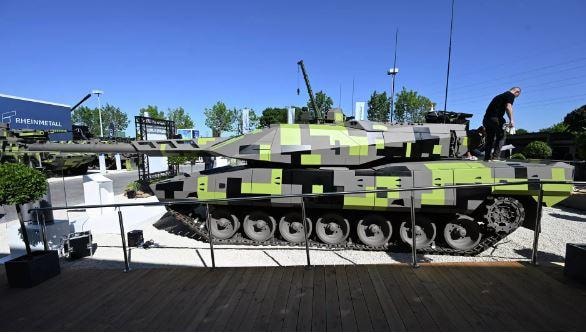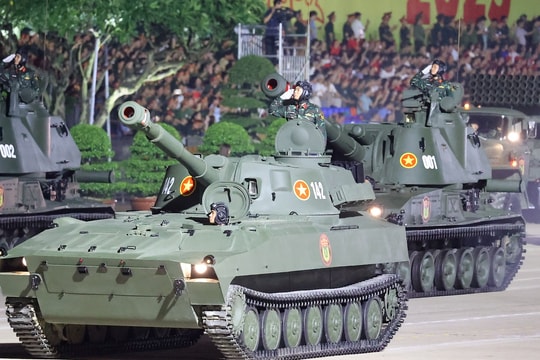'Tank War' - NATO is updating its tank fleet
According to analysts, the developments of the war situation in Ukraine clearly show that, even in the 21st century, in the era of drones and satellites, ground forces still play a decisive role.
The key to victory is a close, coordinated effort between infantry, heavy armored vehicles and artillery on the battlefield. Therefore, NATO's leading countries are accelerating the development of new tanks. Details of these projects - in the Sputnik material.
 |
New generation tank. Photo illustration AFP |
Germany: New tank equipped with drones
At the Eurosatory 2022 international arms exhibition, Rneinmetall Group introduced a prototype of the promising KF51 battle tank. The new vehicle was named "Panther" - a name that is already familiar because the German Panzerkampfwagen V tank, also known as the Panther, participated in World War II.
The new Panther inherits the turret design and some hull components from the Leopard 2A7 tank, but has a smaller combat weight - 59 tons compared to 66 tons.
The main armament of the KF51 tank is a 130 mm gun - a new gun called the Future Gun System (FGS) equipped with an autoloader with 20 rounds in the drum. Rheinmetall claims the FGS has a “50% longer range” than the current NATO standard 120 mm tank gun. The FGS can fire both small-caliber armor-piercing shells and guided high-explosive fragmentation shells. The range is about 5 km. The new tank is equipped with a coaxial 12.7 mm machine gun mounted next to the main gun. A second 7.62 mm machine gun can be remotely controlled from inside the tank. In addition, the tank can fire HERO 120 Loitering cruise missiles from the turret. Each of these “kamikaze drones” carries a 3.5 kg warhead. The drone's flight range is up to 40 km, which will allow the KF51's crew to hit targets beyond visual range. There are also two reconnaissance drones launched from the turret, allowing the tank to conduct local reconnaissance.
Details about the German tank's armor are currently very limited. The company claims that the Panther tank uses not only passive protection (composite steel armor), but also the AMAP (Advanced Modular Armor Protection) active protection system - a modular design that fires projectiles with controlled detonation.
Of course, the 21st century Panther tank is equipped with electronics. A multi-channel sight (thermal imaging channel plus laser rangefinder) in the front part of the turret, a panoramic observation device for the commander helps to detect and identify targets and open fire. The principle of “hunter-gunner” is also implemented: the commander marks the target and the gunner opens fire to destroy it.
France: 140 mm caliber
The French are not far behind the Germans. Nexter has shown off its 140mm ASCALON gun for the Franco-German EMBT "future main battle tank". The gun has been tested on the AMX-56 Leclerc tank, and development is scheduled to be completed in early 2023. The ASCALON is lighter than current 120mm guns and has a longer service life. The gun will use small-caliber ammunition with a tungsten core, and can also use an advanced NLOS (indirect line of sight) guidance system.
The prototype of the EMBT tank (so far with a standard 120 mm gun) was also demonstrated. The chassis of the German Leopard 2 tank, the tower and automatic loader of the French AMX-56 tank. Combat weight - 61.5 tons, engine power - 1500 hp, maximum speed on the highway - 65 km / h, fuel tank enough for 460 km.
United States. Upgraded version of main battle tank
The US company General Dynamics Land Systems is introducing a model of the next generation Abrams battle tank. The prototype will officially launch this fall.
One of the short videos showcasing the new tank suggests that the new version of the Abrams may have some sort of hybrid propulsion system. One often-touted benefit of using hybrids on various military vehicles is the ability to operate in all-electric mode, which is extremely quiet. The developers promise that “they will never hear us coming.” In addition, the new Abrams will be equipped with a remote-controlled weapon station capable of hitting low-flying aerial targets, including drones.
The main caliber of the gun will remain 120 mm. However, the standard gun of the tank will be replaced by the XM360 version with an autoloader. Apparently, they are modernizing the armor of the hull and turret. Most likely, the next-generation Abrams tank will still be equipped with an active protection system. That is, this is not a new tank, but a very deep modernization for modern warfare.
“NATO countries have a reason to focus on the caliber of tank guns,” explains Russian military expert Alexei Leonkov. “After studying modern T-90 tanks that fell into the hands of militants in Syria, they came to a disappointing conclusion: the Russian tank can withstand 120 mm shells. In addition, the ammunition of Russian T-90 and T-14 Armata tanks contains small-caliber shells with armor-piercing feathers that can penetrate 1,000 mm of armor. In the West, there are no such effective shells. Therefore, they decided to develop large-caliber guns.”
The analyst believes that there are no fundamental differences in the new tanks introduced by NATO. The developers only upgraded existing platforms. Therefore, it is not possible to talk about a real breakthrough and “an effective response to the Russian Armata”.
In addition, we recall that the T-14 was originally designed for the 152 mm 2A83 gun. This is the caliber of the howitzer with all its advantages, including the range of destruction of targets. The issue of equipping it on mass-produced T-14s can be solved in a few months.



.jpg)




